
One of the many benefits of eclectic homeschooling is the ability to choose one text for a subject and teach your children as a group at mixed ages. We do this with Bible, worldview, science and history. We’ve also done this with a few other things along the way, such as GrammarLand. And by the way, we love it!
It did seem a little daunting at first, though. I poured through catalogs looking for something made for this purpose, and there’s not much out there. I wondered, “How do you do this?” We’ve been doing group subjects for four years now and I can say: it gets easier as you do it, as you find curriculum you love and and stick with. Really!
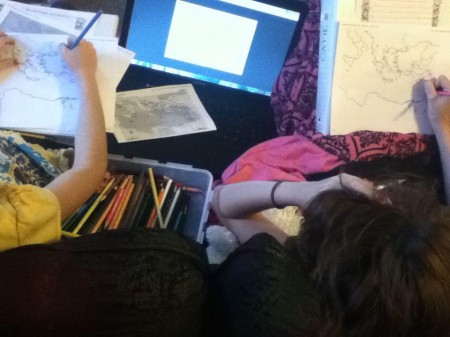
The benefits of teaching a subject for all ages from one text:
So why should you do this? Maybe you’ve considered this but you’re on the fence. Maybe you’ve never really thought about this at all and you think I’m crazy. What are the benefits of teaching group subjects? There are many!
- Curriculum savings – purchasing one text instead of two or three (or four or more!) You still purchase notebooks and other supplies for each child, but you’d purchase those anyway. Also, there’s a good chance you will choose to cycle back around to that text again, for the younger kids who are now older, and now you already own the text and don’t have to purchase it at all.
- Space savings – Again, one text. One book added to the bookshelf instead of two or three (or four or more!) Yes, you’ll hang onto it which will take up space on the bookshelf, but you might choose to create an “off season” storage bin in an attic or closet somewhere for books that you know you won’t be using for a few years. I dig through our “off season” materials at the beginning of each year to take inventory.
- Time savings – Preparing for one lesson instead of many, though you do still have to prepare for a variety of grade-level projects or assignments. Also, everyone sits down and learns the one lesson simultaneously, saving Mom some time from going kid by kid.
- Group experience – I think there is benefit to be gained by individual study and by group experience both. Think about doing a small group bible study, the discussion and insights you gain that are unique to that experience. This isn’t quite the same type of experience if you only have a group of three small children, and yet, there are times that the kids do benefit from hearing each other’s answer, opinion or take on something and the discussion that follows.
- Eclectic ease – You can easily choose texts that fit well with your homeschool style and tailor the grade-level assignments to your preferences. You can assign further reading, essays, hands on projects, notebooking, add documentaries, let the child choose something, or any number of things.
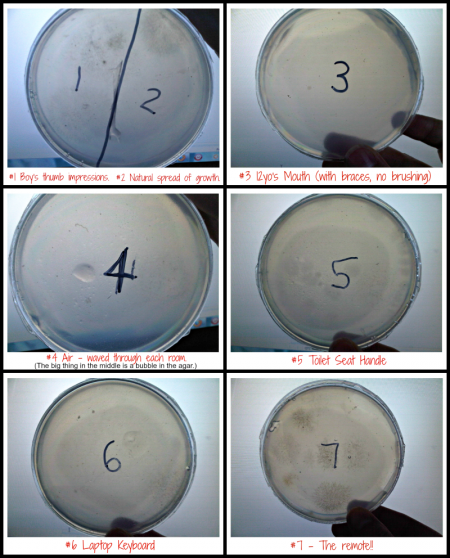
Multiple Ages: How to plan a group subject with one text
Choosing a text for a group subject:
The first question that needs to be addressed for this is “HOW?” Right? The answer is easier than you think. You pick the book you most want to use. It doesn’t matter if it’s made for multiple grades or not. But I do have a few tips for making the decision process a little easier.
- If religious influence (or lack of) is an important factor, start there first and discard those that don’t fit. When I first began searching for a science curriculum to use with all of my children, I started by searching “Christian science homeschool curriculum.” I landed on this comparison page for Christian based science curriculum and from there was able to settle on the Apologia science. For history, I was drawn to the Mystery of History by their emphasis on God’s design and plan throughout history. So start there and then move on from that point. (Note: You can even find recommendations for specific religious views, so try searching the internet specifically, such as “Catholic homeschool science curriculum,” etc.)
- After you’ve narrowed the field, you need to find a text that will be easy to teach to a variety of ages. The text doesn’t have to be built for that intentionally–though there are some and that does help! For example, the Mystery of History has one lesson and then a list of projects or assignments for each age group. However, the most helpful aspect is if a book is NOT written for one grade level only. If it is written for an age or grade range it will be most easily adapted for use with your group of children.
- The last tip is true whether you’re choosing a text for one child or many. After going through the first two steps, look at your remaining options and pour through the samples they provide. Choose the text that appeals to you most, whether because of it’s scope and sequence or the layout of each lesson or some other factor. The download samples from Apologia are what sold me on their product over the remaining others. We have loved Apologia Science from the beginning and have no desire to seek anything else. That may not always be the case (we began with Story of the World history and moved to the Mystery of History.) But you have good odds of finding something you will really enjoy if you do a lot of research beforehand.
Planning individual activities for each age level:
If the text you choose doesn’t already come with individual activities for different age groups, you’ll probably want to plan some in yourself, depending on the subject. I don’t give assignments for Bible and Worldview, these are discussion classes only. Our science comes with accompanying workbooks and our history has recommended assignments so I don’t have to do much of this. However, I do find myself wanting to add or change assignments to a certain extent. Here are some things to consider for help with the assignment process.
- Consider the abilities of each child – younger ones may prefer to draw a picture or reenact the lesson, older ones may be asked to write a summary or further research a certain topic from the lesson.
- Consider your expectations for each child and whether they are being met – daily or weekly writing of paragraphs or essays, for example. Are they writing enough, do they need more? Are they reading enough, do they need more? Would they benefit from hands on projects such as experiments or crafts?
- Consider their interests – we once “derailed” our day for a full day of further research and model building of Mt. Vesuvius and the city of Pompeii (after our history lesson gave us a brief recount of the story but we wanted to learn more.)
Doing Group Projects:
Sometimes you can “kill two birds with one stone” with a group project. I find group projects easier anyway. Most of our group projects are our science experiments. For these, we follow the directions as a group, taking turns doing the steps, and we all observe and discuss the results. The littlest one will orally answer questions and draw a picture in his notebook. The older two will answer questions and write about our experiment and my expectations for how much they write is slightly higher for the older child. Depending on our subject topic we might also add a story book, a documentary or peruse through a picture encyclopedia. We might also do the same for history, adding a piece of literature or a documentary or further researching history events on the internet and writing about our findings.
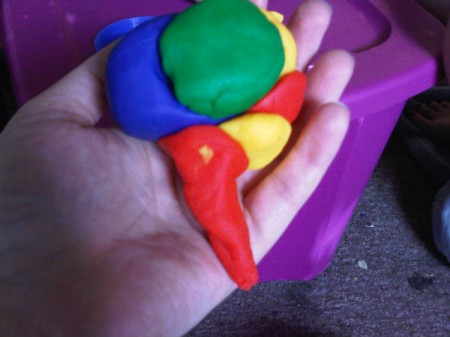
Using binders to keep each child’s work:
The only remaining “problem” is the issue of keeping each child’s work, particularly if you utilize a variety of project and assignment types and do most of the planning on your own. I find binders are the most helpful for this. You can set up a binder for one subject, or one big binder with dividers for each subject. With a binder you can include notebooking pages, worksheets and essays. Using sheet protectors you can include drawings and paintings that you don’t want to hole punch, or items too small to hole punch such as a booklet or piece of origami. You can organize a binder any way that you want to with dividers – by subject, by chapter, by time period, it’s flexible! Teaching a child to organize, keep and maintain their own binders also encourages organizing skills and allows them to create and develop a binder they are proud to show off at the end of the year.
Need more planning help?
This post is just one in a link-up with bloggers from iHomeschool Network. Click the image to see all the homeschool planning posts in this online event.
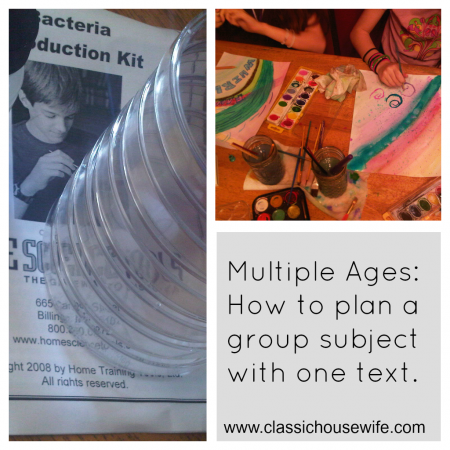
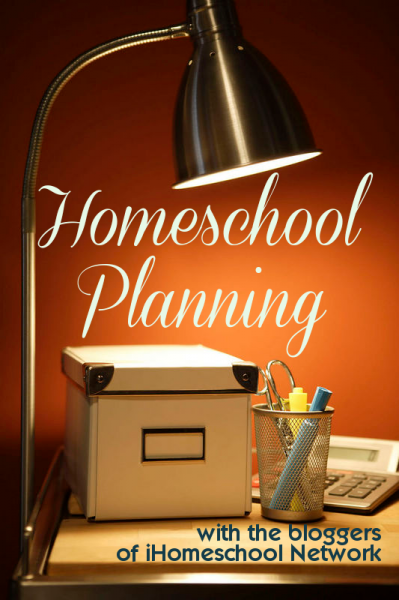


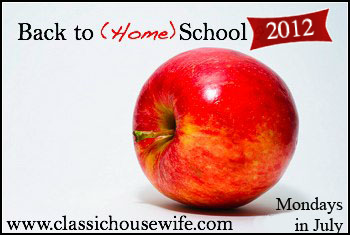

[…] you’re looking for more tips on using one text to teach multiple ages, check out Multiple Ages: How to Plan a Group Subject with One Text at Classic […]
[…] Multiple Ages: How to plan a group subject with one text from Classic Housewife […]
[…] Multiple Ages: How to Plan a Group Subject with One Text at Classic Housewife […]